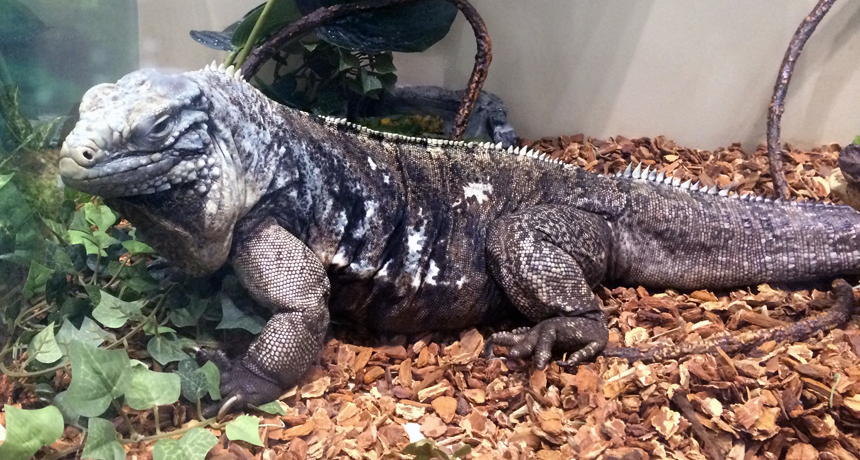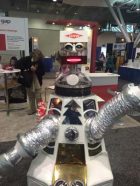Teachers’ meeting brings birds, bones and robots
Exhibitors at the National Science Teachers Association meeting dress to impress

Busch Gardens and Sea Word brought a Cuban rock iguana as an ambassador for their educational materials at the NSTA meeting.
B. Brookshire/SSP
Share this:
- Share via email (Opens in new window) Email
- Click to share on Facebook (Opens in new window) Facebook
- Click to share on X (Opens in new window) X
- Click to share on Pinterest (Opens in new window) Pinterest
- Click to share on Reddit (Opens in new window) Reddit
- Share to Google Classroom (Opens in new window) Google Classroom
- Click to print (Opens in new window) Print
BOSTON – At the annual National Science Teachers Association meeting, everyone is vying for your attention. It started with the keynote speaker, Big Bang Theory’s Mayim Bialik, talking about what inspired her to pursue her PhD in neuroscience. In the meeting rooms and hallways, teachers led classes on how to inspire and educate students in science, technology, engineering and math. And in one mammoth hall, exhibitors have been reaching out to the attendees, asking them to buy their books, try their classroom experiments and invest in their software.
Among all of these exhibitors, a few really stand out. You can’t ignore Skulls Unlimited International, an expert in all things bone. The have a table set up with replica skulls for the classroom. Their examples encompass everything from humans to crocodiles.
Dow Chemical Co. is drumming up attention for its education movement with a chatty little robot named Herbie. He’s been making his way around the conference center, posing for photos and advertising the Dow Teacher Challenge. The contest offers a $1,000 grant to teachers who come up with great ideas to improve education in science, technology, engineering and math.

Of course, who can resist a real live penguin? Busch Gardens has a truck full of exotic animals, including Magellanic penguins (Spheniscus magellanicus) from South America, a Cuban rock iguana (Cyclura nubile), and a stunning Eurasian eagle owl (Bubo bubo). Busch is hoping those charismatic animals will sell teachers on a visit (with classes in tow) to its Busch Gardens and Sea World — or at least get them to pick up its classroom guides and career resources to share with their students back home.
For more sights and sounds from the NSTA meeting, follow Eureka! Lab on Twitter.
Power Words
Cuban rock iguana A species of iguana (Cyclura nubila) found in Cuba and Puerto Rico. The Cuban rock iguana is a large herbivorous lizard, around 60 centimeters (16 inches) long, excluding the tail. They are sometimes used in science to study animal communication.
Eurasian eagle owl A species of owl (Bubo bubo) native to Europe and Asia. It is very large, with a wingspan up to 2 meters (more than 6 feet). They are burnt orange and brown with large orange eyes. The Eurasian eagle owl is nocturnal, prefers rocky habitat with few humans nearby and will eat anything from insects to small deer.
Magellanic penguin A species (Spheniscus magellanicus) that is native to South American countries such as Argentina. They can sometimes migrate as far north as Brazil. They are around 70 centimeters (27.5 inches) tall and eat cuttlefish and squid.
neuroscience Science that deals with the structure or function of the brain and other parts of the nervous system. Researchers in this field are known as neuroscientists.
Twitter An online social network that allows users to post messages containing no more than 140 characters.